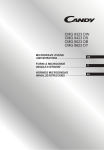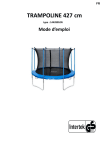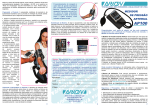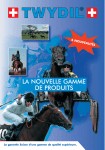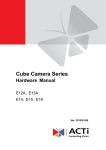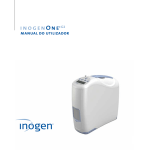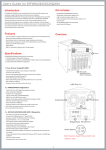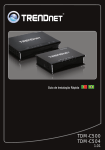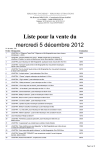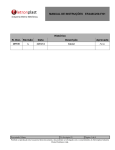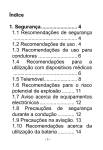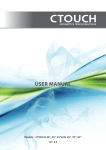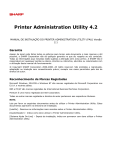Download TRAMPOLINE - Global
Transcript
TRAMPOLINE USER MANUAL INTRODUCTION Before you begin to use this trampoline, you must read all the information in this manual. Just like any other type of physical recreational activities, Participants can be injured. To reduce the risk of injury is sure to follow the appropriate safety rules and tips. Misuse and abuse of this trampoline is dangerous and can cause serious injury! Trampolines are rebounding devices which propel the performer to unaccustomed heights through a variety of movements. So always use caution when playing on a trampoline. Always inspect the trampoline before each use. Proper assembly, care and maintenance of product, safety tips, warnings, and proper techniques in jumping and bouncing are all included in this manual. All users and supervisors must read and familiarize themselves with these instructions. Anybody who chooses to use this trampoline must be aware of their own limitations in regards to performing various jumps and bounces with this trampoline. Initially, you should get accustomed to the feel and bounce of the trampoline. The focus must be on your body position and you should practice each fundamental bounce until you can do each skill with bounce before moving on to more difficult and advanced bounces. Do not bounce recklessly on the trampoline, emphasis must be made on good control and the mastering of various bounce techniques No more than one person is allowed on the trampoline! Multiple jumpers increase the risk of injury resulting from min-air collisions. Do not perform somersaults (flops) as this will increase the chances of landing on your head or neck. Paralysis or even death can result TRAMPOLINE GUIDELINES 1. GENERAL INSTRUCTIONS 1.1 PURPOSE The product is intended for home/domestic use only and is not suitable for professional or medical uses. The maximum weight is 150kg. Overloading the trampoline above the recommended user weight will cause damage to the trampoline which is not covered by the warranty 1.2 DANGER FOR CHILDREN Do not let unsupervised children near this product. Carry out the necessary safety precautions and supervise all trampoline activities. Be aware that the packaging material is not suitable for children. There is a danger of suffocation! Trampolines over 51cm (20inches) in height are not recommended for children under 6 years of age. Children do not recognize potential dangers from this product. Keep children away from this product, it is not a toy. The product has to be stored out of reach of children and pets. 1.3 ATTENTION – PRODUCT DAMAGES Do not alter the product. Only use original spare parts. Repairs should only be carried out by qualified technicians. Improper repairs can compromise the safety of your trampoline. Use this product only as described in this manual Protect the product against humidity and high temperatures. 1.4 ADVICE FOR THE ASSEMBLY The assembly of the product must be done carefully by at least two able-bodied adults. If in any doubt, ask a technically qualified person. Before you start assembling the trampoline, read all the instructions in this manual. Remove all packaging materials and lay down all parts on a free space. This gives you an overview and simplifies the assembly procedure. Check with the parts list that no parts are missing. Dispose of the packaging material when the assembly is completed Beware that when using tools or doing technical work, there is always a risk of injury. Therefore assemble the product carefully. Create a danger free environment, for example: do not let tools lie around the workspace. Store the packaging material in a way that cannot cause any danger. Foils and plastic bags are dangerous for children (danger of suffocation)! After installing the product acceding to the instruction manual, please make sure that all screws, bolts and nuts are correctly installed and tightened and that all joints are tightly fixed. A clearance space of at least 7.3m is necessary above the trampoline. An appropriated clearance must be kept between the trampoline and possible sources of danger, such as electric cables, tree branched, playing devices, swimming pools and fences. The trampoline must be set up properly before use. Never set up the trampoline in rainy, windy or stormy conditions, especially lighting conditions..it is recommended that the trampoline be taken apart and stored in bad weather. The metal frame of the trampoline will conduct electricity. Lightning, extension cords and all electrical equipment must never be allowed to come in contact with the trampoline. The trampoline must always be used in a well-lit area. Do not place any objects under the trampoline. The trampoline in the vicinity of other leisure devices and constructions must not be used. When assembling or disassembling, please use gloves to protect your hands. 1.5 ADDITIONAL TIPS For additional stability you can place sand bags on the trampoline legs. This will prevent the trampoline tromp tipping over in the event of any sideward’s force. Do not use during pregnancy. Do not use when suffering from high blood pressure. Jump with bare feet. Do not wear shoe, this will damage the jumping mat which is not covered by the warranty. No smoking Do not put cigarettes. Pets, sharp objects, or any other foreign objects, or any other foreign objects on the trampolines. Do not use the trampoline whilst under the influence of alcohol or drugs. Do not sit or lean on cover pads as it needs to be feeble so it can move with the jumping mat. Please do not allow small children to pull themselves up the trampoline by using the cover pads. Tears in stitching caused by obstructing frame pads are not covered by warranty. Place trampoline on level ground. Preferably on grass. Locating the trampoline on hard surface will add stress to the frame and overtime cause damage which is not covered by the warrant y. placing the trampoline on an uneven surfaces may result in the trampoline tipping over. Don not expose the trampoline to direct contact with open flames. Secure the trampoline against unauthorized use. Do not use if trampoline is wet. Trampoline should be tied down with anchors during windy conditions or dismounted and stored away. 1. 2. WARNING Please ensure that the safety enclosure net zipper is 100% closed and all three entrance hooks are re-hooked before jumping. Do not intentionally jump into the safety net, it is only designed to stop persons from falling off the trampoline. Intentional jumping into the safety net may cause the trampoline to top over, or may damage your net. Abuse of the safety net is considered negligent use which is not covered by the warranty, please refer to the disclaimer. 2. SAFETY INSTRUCTIONS FOR TRAMPOLINES All user of the trampoline need a supervisor. Regardless of the age and the experience of the user. The safety instructions of the trampoline should always be considered and obeyed. Somersaults must be avoided. Incorrect ladings on the trampoline can lead to injuries, particularly to the back, neck or head. Injured may include paralysis. Or even death. Only one person should use the trampoline at a time. Multiple users on the trampoline will increase the risk of collision. The trampoline has to be examined for damaged, wearing or defective part before each usage, as it can impair the overall safety of the trampoline. The damaged, wearing or defective parts should be replaced immediately. In the meantime the trampoline must be restricted from access. No clothes with hooks or parts may be carried when jumping on the trampoline, in order to avoid hooks getting caught. The trampoline must be set up only on a flat ground and non-slippery surfaces/ Strong wired can blow the trampoline away. If strong winds are predicted. The trampoline must be moved to a protected place, and taken apart. Or fastened to the ground with cords and herrings. Ai least three anchorages are necessary. It is not enough to anchor the pennants in the ground since the can tear out of the patch cords. Try to avoid the moving the assembled trampoline, because it could bend during transportation. Should it be necessary to move the trampoline, please consider the following: at least four people must be evenly spaced around the frame to lift the trampoline off the ground. The trampoline must be carried horizontally, and if the frame shifts position use four people to draw the trampoline in shape. Trampoline are jumping devices, enabling the user to jump to unusual heights as well as into a multiplicity of body movements. Jumping into the trampoline. Hitting the frame, cover pads or incorrect landing on the trampoline can lead to injury. Users should be familiar with the user manual. This manual contains assembly instructions... selected precautionary measures as well as recommendations for servicing and maintenance of the trampoline. In order to ensure a secured and fun use of the trampoline. It is the responsibility of the owner of the supervisor to guarantee that all users of the trampoline are informed sufficient space around it as a safety precaution. Never use it near water and keep sufficient space around it as a safety precaution. Beware of moving parts. Which could catch your arms and legs? Do not stick any foreign objects in to the trampoline, Do not allow anyone or any object to go under the trampoline whilst someone is jumping on the mat. The jumping mat is flexible and downwards force create by someone jumping can cause serious injury to a person. Implement all safety rules and make yourselves familiar with the information in the user manual The trampoline can be only used, if the jumping mat is clean and dry. Worn or damaged jumping mats should immediately be replaced. Object, which could be dangerous to the used, should be vacated from the area Avoid unauthorized and unsupervised use of the trampoline. Do not use the trampoline under influence of alcohol or drugs(inch medicines) Learn the fundamental jumping techniques thoroughly. Before trying difficult jumps. For more information. See section-fundamental bounce techniques. Climb on the trampoline. Do not jump on it directly. Do not use the trampoline as jump board for other articles. For more information, see section-accident categories: mounting and dismounting Pour de plus amples informations ou documents exercice, vous pouvez passer à un professeur de trampoline qualifié. TRAMPOLINE PARTS LIST ITEM MODEL SIZE 55”/1.4m 6’/1..8m 8’/2.4m 10’/3m 12’/3.7m 13’/4m 14’/4.27m 15’/4.57m 16’/4.88m A TOP RAIL 6 6 6 6 8 8 8 10 12 B COVER PADS 1 1 1 1 1 1 1 1 1 C JUMPING MAT 1 1 1 1 1 1 1 1 1 D SPRINGS 30 36 48 60 72 80 84 90 108 E LEG EXTENSION 6 6 6 6 8 8 8 10 12 F LEG BASE 3 3 3 3 4 4 4 5 6 G SCREWS 6 6 6 6 8 8 8 10 12 H SPRING FIXING TOOL 1 1 1 1 1 1 1 1 1 55inch/6ft/8ft/10ft-1 Trampoline (3legs) 16ft Trampoline (6legs) 12ft/13ft/14ft Trampoline (4legs) 15ft Trampoline (5legs) TRAMPOLINE ASSEMBLY Refer to PARTS LIST for identification of parts. WARNING: Two adults in good physical condition are required for the following assembly .For your safety, you should wear proper shoes and clothing. Failure to follow these instructions and warnings may result in injury. NOTE: Picture may vary slightly with different trampoline models 1. Lay out all the trampoline parts in groups, as shown above. 3. Attach all the top rails to form a large circle, Joining the last link may require two people .The second person should hold the opposite side, while you bring both ends of the circle together. 2. Attach the leg extensions to a leg base and secure together with the screws. Repeat for all leg supports. 4. Attach the all leg supports you assembled in STEP 2 to the top frame. 5. wdfdfewrr 5. Attach the leg support to the top frame and tightly secure together with the screws. 7. With stitching portion facing down, lay jumping mat inside frame and attach a spring into one of the triangle rings on the mat. Then attach the other end of the spring to the frame. 6. At this stage the trampoline should like the picture above. 8. 9. Repeat STEP 7 directly across from where you attach the first spring. Then attach two more springs half distance between the first two springs, directly across from each other. This will ensure equal tension is distributed between the springs. . 9. Repeat process for the remaining springs. Use the spring tool, as shown above . Warning: During spring assembly, please be careful where you place your hands other parts of your body as connector points 10. Springs under heavy tension may require adjacent springs to be attached at every four or five holes, so the spring tension is distributed equally. Attach the remaining springs until all springs are attached onto the frame. 11. Lay the cover pads on the outer edge so the springs are covered. 12. The all the cover pad’s strings onto the top rail of the trampoline.Proceed to Testing the Trampoline section of this manual before jumping on the trampoline. 14. ENCLOSURE PARTS LIST Item mm A B C D E F G H Outer Net With Standard Poles Model Size Upper Pole& Foam Lower Pole& Foam Bolts piece Safety Enclosure Net Spacers pieces Nut piece Washer Spanner 55” 6 6 12 1 12 12 12 1 6’ 688m 6 12 1 12 12 12 1 8’ 6 6 12 1 12 12 12 1 10’ 6/8 6/8 12/16 1 12/16 12/16 12/16 1 12’ 8 8 16 1 16 16 16 1 13’ 8 8 16 1 16 16 16 1 14’ 8 8 16 1 16 16 16 1 15’ 10 10 20 1 20 20 20 1 WARNING: At least two adults in good physical condition are require for the following assembly. Wear proper shoes and matian balance to prevent a fall. Failure to follow all instructions and warnings exactly may result in serious injury. 16’ 12 12 24 1 24 24 24 1 SAFETY ENCLOSURE ASSEMBLY Refer to PARTS LIST for identification of parts. WARNING: Two adults in good physical condition are required for the following assembly. For your safety, you should wear proper shoes and clothing, Failure to follow these instructions and warning may result in injury. NOTE: picture may vary slightly with the different trampoline models. INNER NET ASSEMBLY 1.Lay out all parts prior to assembly. We recommend that two people carry out the assembly. Now get ready for poles assembly. 2.Standard Poles Assembly: Use the quick clamp to secure the enclosure pole to the upper hole of the leg extension and the hole of top rail’s welded tube. Use another quick clamp to secure the enclosure pole to the lower hole of the leg extension and the hole of “U” shape leg You need use the spanner included to secure the nut for standard pole. Standard pole 3.Repeat Step 2 to make sure all the screws tight with the extension tubes, The trampoline now looks like this. 5.Repeat Step 4, assemble all the safety net poles as shown in the photo, The trampoline now looks like this. 4.Fit the upper pole by pushing them down to the readily assembled poles. Make sure that the poles steady enough. 6.Now you must fit the netting. Place the netting on the top of the pole, and pull it down. You need to consider each pole when you pull the net down 7. Then tie the netting securely to the triangle rings of the trampoline mat. Repeat this step to make sure all the plastic parts of the netting tie to the Rings. As shown in the photo. 8. Your netting is now fully fitted. Proceed to Testing the Trampoline section of this manual before jumping on the trampoline. TESTING THE TRAMPOLINE After assembling the trampoline, it is important that you perform the following safety checks: Trampoline Safety Checks: Using a screwdriver, check if all the screws are tightly secured. Look underneath the trampoline and check all the springs are hooked securely to the frame and triangle rings. Move the trampoline around and check the sturdiness of the frame. Using your two hands, put your body weight on one section of the trampline and release to check that the floor is even. Inspect the cover pads and check if they completely cover the springs and frame. Make sure the strings of the pads are tied securely. Enclosure Net Safety Checks: Hold onto pole net jacked and check that all the enclosure poles are sturdy by shaking it. Check the enclosure net and pole jacket for any tearing in the stitching or material. Check the enclosure net zipper and entrance hooks function properly. Check to see if all safety encloure hooks are attached to the triangle ring underneath the trampline Once all the checks are performed and the trampolines are passed all the intial test (above),then test the trampline by jumping on the centre continuously for 5 minutes. If the trampoline feels sturdy then you passes the test. Remember to abide by all the safety rules. Have fun, play safe FUNDAMENTAL BOUNCES TECHNIQUES All trampoline users are recommended to understand and perfect these fundamental bounces. THE BASIC BOUNCE O SALTO BÁSICO Start from a standing position, width na apartesteira with head Comece duma posição defeet pé,shoulder os olhos and eyes on the trampoline Balance suas armas à bed frente e para cima, dum Swing your arms forward and up and around in a circular motion. movimento circular. Bring feet together in mid-airenquanto and point toes downward. Deixe pés estarwhile juntos no ar e Keeping feel shoulder width apart when landing on mat. apontar os dados do pé para baixo. Deixe pés estar saparados quando aterra na esteira. THE BRAKING MANEUVER Occasionally the may lose control of their jump and bounce wildly. Lard on your hands and knees keeping your back straight. Emphasis should be directed at a good four-point landing. And not Start with a low controlled basic bounce. Lard on your knees keeping back straight. body erect and use your Please hands on mat beside your hips. A PARADA DE SALTO Performing the braking maneuvered will allow the user to regain Ocacionalmente, o usário perde controle de control of the jump and their balance. salto dele. Executar a parada de salto vai Start with a basic bounce. permitir o usário a controlar novamente o salto As you land, bend your knees sharply and this will allow you to stop e sua balança. your jump. Comece com um salto básico. Quando você aterra, curve seus joelhos com THE HANDS AND KNEES BOUNCE severidade. Isso vai permiti-lo a parar seu Start with a low controlled basic bounce. salto. O SALTO DE MÃOS E JOELHOS on jumping height. Comece com um salto básico. Adicione força nos seus mão e joelhos, deixando suas costas directos. Você deve dar importância na aterragem, mas não na altura KNEE BOUNCE de salto. O SALTO DE JOELHO arms to maintain balance. Comece com um salto básico. Bounce back to the basic bounce position by swing your arms up. Adicione força nos seus joelhos, deixando suas costas directas. Levante o corpo e use os braços para manter a balança. Balançe os seus braços para deixar o salto SEAT BOUNCE voltar à posição Land in a flatbásica. sitting position. O SALTO DEtoASSENTO Return erect by pushing with your hands. Aterre com uma posição de sentar. Coloque braços na esteira, ao lado da sua coxa. Empurre os seus mãos para voltar para posição ereta.
















